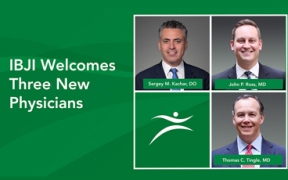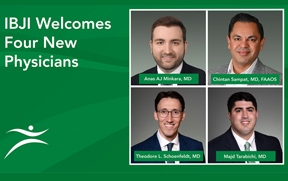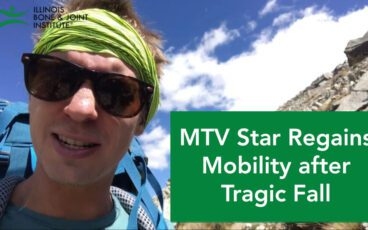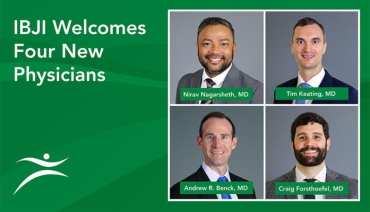In October of 2018, Gregory was working at the airport when he suffered a traumatic injury to his right leg. While helping other coworkers out in the baggage area, Gregory was struck by a dolly cart, which carries luggage, and was dragged by the cart for a few feet.
“At first, I didn’t feel anything from the adrenaline rush. There wasn’t much pain but I felt a burning sensation. When I lifted my leg slowly, that’s when I knew something was wrong.”
Coworkers ran to assist Gregory. They helped wrap him up and got him water while they awaited the ambulance.
Once at the hospital, x-rays were taken to reveal a traumatic open tibia fracture. Gregory had 8 cm of bone loss from the injury.
“I remember [the doctors] looking at the xrays and saying it was serious and that there were bone fragments everywhere. Everything was a blur and I was in and out of it. I don’t remember much after the accident happened.”
IBJI’s Dr. Jeffrey Goldstein was on call when the injury occurred. Dr. Goldstein performed the first emergency surgery and then contacted IBJI’s Dr. Brian Weatherford to take over Gregory’s care.
Dr. Weatherford explains the surgery process, “Dr. Goldstein cleaned the fracture and performed external fixation. An external fixation is a surgical treatment where pins are placed into the bone and attached to bars on the outside of the body. When I stepped in for the next surgery, I removed the external fixation, placed a titanium rod in the tibia and placed antibiotic cement to fill the space where the bone was lost. At the third surgery, I replaced the antibiotic cement with a bone graft taken from Greg’s femur.”
Gregory said, “I was able to put a little pressure on my leg here and there but not too much. I had crutches that I was back and forth on and a full brace when I had my first bone graft surgery. That’s when Dr. Weatherford said the bone wasn’t growing back well so we went to a fourth surgery.”
Dr. Weatherford could see that the bone graft was not healing as he’d hoped and offered to try a magnetic bone transport nail. Greg and Dr. Weatherford discussed the risks and benefits of this procedure compared with alternatives and decided to proceed. This was the first time this device had been used in Chicago.
Dr. Weatherford describes what the magnetic bone transport nail does, “I contacted the company that made the Bone Transport Nail. I knew it was in alpha testing and Greg was the right candidate for it. The company approved me to be an early adopter or alpha tester of the device. Patients with this amount of bone loss would traditionally be treated with a device known as a circular external fixator. These devices use the principle of distraction osteogenesis. Basically you make a cut in the bone (osteotomy) and let the bone start to heal for 1-2 weeks and then gradually pull apart the healing bone tissue. This forms new bone that is called regenerate. The problem with these devices is that they are very painful to wear with pins and wires sticking out of the skin for months."
Dr. Weatherford continues, "The bone transport nail uses the same principle of distraction osteogenesis but it is all inside the body with no wires or pins sticking out of the skin. I made a cut in upper end of the tibia bone and placed the nail. Greg used a device that activates a small motor driven by a magnet in the nail. He put this over his leg twice a day starting at 10 days after surgery and it slowly took a section of bone from his upper tibia to his lower tibia. As this piece of bone was being pulled down slowly over the nail, new bone (regenerate) formed behind it filling the defect.”
On the third day of using the magnetic bone transport nail, Gregory experienced some pain. He felt a pull and a pop but he did not experience any pain after that day. He says that he used the device three times a day at 4 a.m.,12 p.m., and 8 p.m.
Gregory’s fifth surgery consisted of changing out the screws in the nail so that bone regeneration could continue. At the sixth surgery, Dr. Weatherford removed the bone transport nail and placed a standard tibia nail with a bone graft.
After his sixth surgery, Dr. Weatherford told him that “everything was going well and it’s going to be a long recovery.”
During his time between surgeries, Gregory’s Mom and Dad helped him around the house. “I could hardly do anything, walking was hurting. I also had two home health people come in to change the wraps on my leg and to see my progress. They did this until the stitches came out.”
Gregory started physical therapy in January 2020. He reflected on his experience, “Physical therapy was hard in the beginning, I couldn't lift or push anything or walk. Therapy was tough trying to build strength but I am gradually improving.”
Now in recovery Gregory says, “I can walk but not quite as well, but now I can actually get up and walk around. I have a brace to help out and still practice picking up weights. I remember in the beginning I asked if I would walk again, [the doctors] looked at me like they didn’t know because of how traumatic the injury was. They said that most people with my damage wouldn’t be able to walk. But now they are amazed by what I have been able to do. The body is incredible in how I’m moving again.”
“I want to thank Dr. Goldstein and Dr. Weatherford for really working hard and trying to get me back to walking. I know I won’t be 100% but I want to thank him for his efforts.”
Brian Weatherford, MD, is an Orthopedic Surgeon with fellowship training in both foot and ankle and trauma surgery. He is dedicated to the treatment of patients with foot and ankle disorders as well traumatic musculoskeletal injuries.




